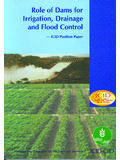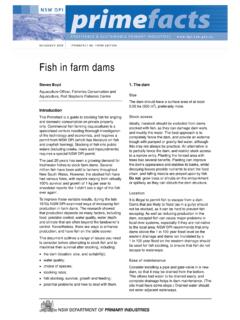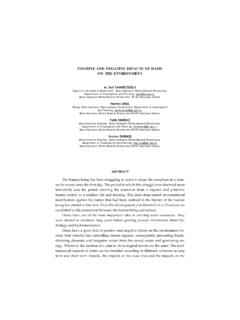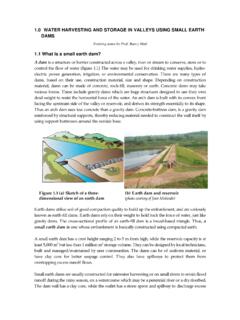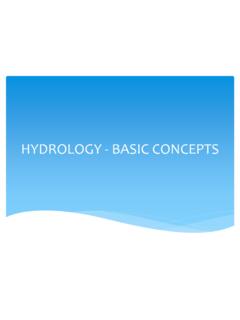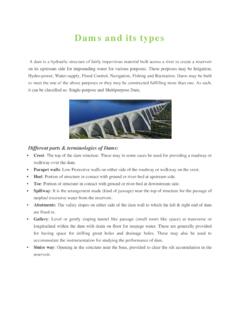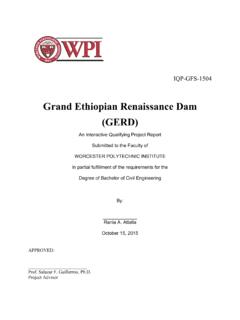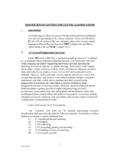Transcription of Manual on small earth dams
1 ISSN 0254-5284 FAOIRRIGATIONANDDRAINAGEPAPER64 Manual on small earth damsA guide to siting, design and construction 64 FAOM anual on small earth dams - A guide to siting, design and constructionManual on small earth damsA guide to siting, design and constructionFOOD AND AGRICULTURE ORGANIZATION OF THE UNITED NATIONSRome, 2010 FAOIRRIGATIONANDDRAINAGE PAPER64byTim StephensInvestment Centre DivisionThis Manual has been prepared to help practitioners design and construct small earth dams in rural areas. It reflects FAO s and the author s best judgement and knowledge on the subject. Every reasonable effort has been taken to ensure that the information contained in this Manual is complete, accurate and correct. FAO declines responsibility for any error or omission and in no event shall FAO be liable for any loss of business or profit, or for any direct or indirect, incidental or consequential damages arising out of any use of this Manual . If users require engineering or other professional services, the assistance of an appropriate professional should be Food and Agriculture Organization of the United Nations encourages the dissemination of material contained in this publication, provided that reference is made to the designations employed and the presentation of material in this information product do not imply the expression of any opinion whatsoever on the part of the Food and Agriculture Organization of the United Nations (FAO) concerning the legal or development status of any country, territory, city or area or of its authorities, or concerning the delimitation of its frontiers or boundaries.
2 The mention of specific companies or products of manufacturers, whether or not these have been patented, does not imply that these have been endorsed or recommended by FAO in preference to others of a similar nature that are not mentioned. The views expressed in this information product are those of the author(s) and do not necessarily reflect the views of 978-92-5-106547-1 All rights reserved. Reproduction and dissemination of material in this information product for educational or other non-commercial purposes are authorized without any prior written permission from the copyright holders provided the source is fully acknowledged. Reproduction of material in this information product for resale or other commercial purposes is prohibited without written permission of the copyright holders. Applications for such permission should be addressed to the Chief, Publishing Policy and Support Branch, Office of Knowledge Exchange, Research and Extension, FAO, Viale delle Terme di Caracalla, 00153 Rome, Italy.
3 Or by e-mail to: FAO 2010 IIIC ontentsAcknowledgements viAcronyms, abbreviations and symbols vii 1 Introduction 12 Background Safety aspects and scope of the Manual irrigation Community participation Social and gender aspects The USBR Manual on small dams 103 earth embankments The homogeneous embankment The zoned embankment Cutoff trench and core 164 earth works Investigations Soils Mechanical analysis Laboratory tests Borrow areas 275 Site selection and preliminary investigations Aerial Field visits Preliminary surveys Catchment yield Storage capacity Preliminary volume of Catchment area and spillway Peak Calculating the PMF using the rational method Estimates of storage required396 Detailed Contour Revised capacity Revised volume of Design Estimated cost of dam construction Outlet The Core depth and Crest width Settlement Stone pitching
4 And training Seepage Filters and drains Environmental issues 567 Dam construction Setting out the dam site Plant and equipment Compaction equipment and Site clearing and Settlement Spillway Constructing the embankment 668 Special cases Introduction earth embankment on rock foundation earth embankment using poor earthwork material An existing embankment with seepage problems Masonry centre spill dams Bulldozer dams dams in low rainfall areas Estimating capacity in a raised dam 759 Finishing works Introduction Inspection requirements Training banks Other works Maintenance procedures Trees and bushes Erosion Termites and animal burrows 8510 Repair work Introduction Structural defects Non structural defects 93 Bibliography 95 Glossary 96 Annex 1 Procurement guidelines for tender preparation, evaluation and award of contract101 VAnnex 2 Cost benefit analysis 109 Annex 3 Fish production in farm dams 112 Annex 4 Examples of standard drawings 115 VIAcknowledgementsThe preparation of this book was funded by the Investment Centre Division and the Land and Water Division of the Food and Agriculture Organization (FAO) with initial financial support from the World Bank-funded Country Water Resources Assistance Strategy in Zambia.
5 The author wishes to acknowledge the support provided by many colleagues who contributed valuable insights, advice, criticism and editorial comments as well as photographs. M. Henri Tardieu is gratefully remembered for his technical review, the Dew Point DFID Development Resource Centre for Environment, Water and Sanitation for facilitation of a review of the Manual by Professors R. Carter and M. Hann, colleagues in the Investment Centre and Land and Water Division of FAO, and to Jose Luis Castilla Civit and Jim Morgan for the formatting, layout and graphic design Manual is based in parts on a publication by the author on the same subject and published by Cranfield Press (Stephens, 1991).VIIA cronyms, abbreviations and symbolsA Area of the catchment (km2)A Area of the reservoir at full supply level (ha or m2)CAP Crisis Action PlanD Maximum depth of spillway at the crestDFID UK Department for International DevelopmentESP Exchangable sodium percentageFSL Full supply levelGPS Global positioning systemL Length of the dam at full supply levelH Crest height of dam at full supply level (m)H Maximum height of dam at full supply level (m)H Freeboard height (m)PMF Probable maximum floodQ Dam capacity (m3)T Throwback (m)UNFPA United Nations Population FundUSBR United States Bureau of ReclamationUSDA United States Department of AgricultureY Catchment yield (m3) Introduction11.
6 Introduction11 IntroductionThis Manual is designed specifically for engineers, technicians and extension workers involved in agriculture, commercial farmers and contractors all with some understanding of engineering and some experience of dams , irrigation and water supply involved in the siting, design and construction of small earth dams in the drier parts of the African continent. Such dams are suitable for supplying water to irrigation schemes, for rural and other water supplies (when properly treated) and for conservation measures. The Manual is derived from the author s many years of experience in dam design and construction in a number of countries in west, central and southern Africa and has been drafted with a view to providing, for the first time in this field, a colla-tion of practical and useful guidelines for siting, designing and constructing small dams . Although derived from training and experience in Africa, the Manual will be applicable to many other parts of the world and hence its publication by FAO.
7 Thus, the Manual essentially provides a comprehensive and pragmatic means for the practical understanding of the principles and procedures used in small earth dam construction and for the users to safely and competently construct small dams without recourse to the costly, complex and sophisticated design and construction techniques associated with dams on larger catchments. The Manual includes an introduction to community participation, social and gender issues in siting, constructing and operating dams , environmental issues and fish production as well as sections on costing dams , tendering for construction and awarding contracts. Background22. Background52 Background INTRODUCTIONIn many tropical, subtropical and Mediterranean climates, dry season agriculture and the pre-rainy season establishment of food and cash crops cannot be under-taken without large quantities of water. To rely upon streamflow at a time when temperatures and evaporation are often at a peak can be unrealistic and risky.
8 It may become essential for a dam to be constructed on a river or stream to allow for off-season storage of vital water supplies. Although primarily for irrigation , such structures can be used, either separately or combined, for fish farming1, stock and domestic water purposes, drainage sumps, groundwater recharge, flood ameliora-tion and conservation storage. SAFETY ASPECTS AND SCOPE OF THE MANUALIn all dam construction, safety must be given priority and users of this Manual should follow the guidelines below: Users should restrict themselves to the construction of earth dams no higher than 5 m from streambed to finished crest level. dams on catchment areas exceeding 25 km2 or with reservoir areas storing more than 50 000 m3 may require the advice of a hydrologist to assist in the design of spillways and other outlets and for the estimation of freeboard. No spillway should be less than 10 m wide and 1 m deep for catchments up to 5 km2 and should be at least 15 m wide and m deep for catchments exceeding this area.
9 Any dam that involves out of the ordinary topography ( steep slopes upstream, risks of landslips), hydrology ( flash floods , droughts, snowmelt) or soils ( poor quality soils, sodic soils, permeable layers in the soil, bare earth surfaces in the catchment) should only be designed and constructed under the supervision of a qualified engineer. Before any dam is constructed, an assessment of the hazard potential should be made. This section and Table 1 provides guidelines:Table 1: Hazard potentialLoss of lifeEconomic lossHazard potentialAlmost impossibleNegligibleNoneExtremely unlikelyMinimalVery lowImprobableMarginalLowPossibleApprecia bleModerateProbableExcessiveHighA dam that is assessed with a high hazard potential should not be built without guidance, for both the design and construction, from a qualified engineer. dams assessed as having moderate2 or low hazard potential may need design modifica-1 Refer to Annex 3 for more Sometimes an extra category significant is added to this sort of table between high and moderate.
10 Equally the word hazard can be changed to on small earth dams6tions, including increasing the return period for the design flood, to mitigate the perceived risks, improve stability and reduce susceptibility to flood flows or over-topping. Increasing freeboard or designing the spillway for the passage of larger flood flows (including having emergency spillways ) can reduce risks to dams from extreme rainfall events. Other modifications that can be made to the embankment are designing for flatter, more stable slopes (especially on poorer foundations or when using poorer earth materials), the introduction of seepage relief measures such as drains and filters and additional mechanisms to permit the release of water from the dam to lower water levels at times of hazard. This is further discussed all dams , except those assessed with no hazard potential, a Crisis Action Plan (CAP) should always be prepared. At a minimum this will comprise: Contact names and telephone numbers (owner of the dam, authorities downstream, police and emergency services and others) to call if the dam is damaged, develops problems or is considered unstable.










